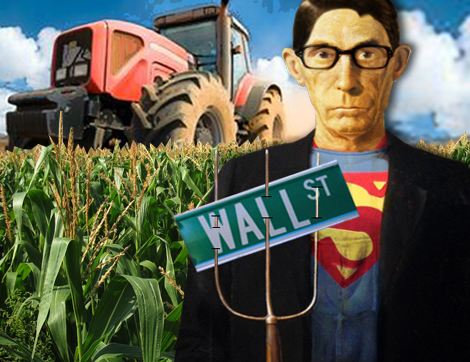
• With 400 million acres of arable land around the U.S. coming up for sale in the next two decades, Big Government and Big Business have America’s family farmers in their sights.
By Ronald L. Ray —
American family farms and the country’s food supply are in danger as never before. During the next 20 years, 400 million acres of United States farmland—nearly half of the total—will be for sale. And Wall Street is ready to snap up the opportunity like a fox in a hen house, states a new report by the Oakland Institute entitled “Down on the Farm.” In addition, corporate Big Agriculture and its government lackeys press ahead with other efforts, which endanger the continued existence of small- and medium-sized farms.
Since the 1940s, the number of farmers in this country has collapsed by 85%, although the general population has doubled, according to the advocacy group, Farm Forward. Prior to that time, 40-80 acres produced sufficient income to raise a large family. Now, thanks to predatory banking and commodities-trading practices, the cost of technology and government intrusion, it requires nearly 1,200 acres to accomplish that goal. An estimated 99% of U.S. livestock is raised on factory farms, often in cruel, unsanitary conditions, which also pollute the local environment.
Today, the majority of farmers are over 55 years of age. That is a demographic death knell. While many of the younger generation would like to enter or remain in farming, they have no access to the massive capital now required. When the older generation quits, dies or sells out, so may most family farms.
Presently, corporate farms and ranches comprise only about 1% of all agricultural operations, but Wall Street investment firms like UBS Agrivest and TIAA-CREF Teachers Insurance and Annuity Association – College Retirement Equities Fund (a massive teachers’ pension fund) are greedily eyeing the 15%-25% of farmland that is considered “institutional quality.” This land speculation, more for capital gains than anything else, is driving up land and food prices.
The amount of land in tillage is dropping, meanwhile, as corporate owners convert a part to non-food uses, like wind farms and “fracking” for oil and gas, without regard for protecting fragile water resources, such as the Ogallala Aquifer. There is the additional problem of diverting increasing amounts of grain to fuel and animal feed uses rather than feeding human beings. And corporations are “absentee landlords,” whose lack of knowledge and concern for the land leads to serious labor and environmental abuses by management companies.
Big Ag firms Monsanto and DuPont are developing “prescriptive planting” technology that, in addition to the legitimate uses that help farmers, could ultimately harm them. John Deere, for example, has signed a contract to beam data relating to production directly from its tractors to Dow Chemical and DuPont, according to The Wall Street Journal. The information could be used easily by unscrupulous brokers to corner commodities markets and deprive farmers of a legitimate profit.
Elsewhere, the Department of Agriculture is poised to deregulate completely several new strains of genetically-modified corn and soybeans designed to tolerate increased application of the dangerous herbicide, 2,4-D. Australia recently banned the chemical due to its serious adverse health effects and frequent contamination with deadly dioxin. Many crops and fruits can also be killed by wind drift of the poison.
Finally, a growing number of states have passed or are considering unconstitutional “ag-gag” laws, which criminalize whistleblowing efforts to expose livestock abuse, primarily on factory farms. The latest, Idaho, follows Kansas and others by prohibiting not just clearly illegal activities, like trespassing, but even taking photographs or videos without the farm owner’s permission.
But there are small signs of hope. Advocacy groups continue to form in defense of family farming, since the Farm Bureau long ago sold its soul to Big Ag. And organizations like the Agrarian Trust work to assist young and aspiring farmers in obtaining financing to achieve their dream of a sustainable family farm, helping to feed the world—or at least a small corner of it.
Is it time to consider a new Homestead Act, one that would provide some of this newly available farmland to resident family farmers at low cost? Besides establishing a stable, “back to the land” movement, the necessary loans to individuals could be amortized over ten years and reduced by 25% for each child born on the farm or for a certain level of production. The money would be recouped by the government from the additional consumption taxes paid by the growing farm population. We think it is a great idea.
Ronald L. Ray is a freelance author and an assistant editor of THE BARNES REVIEW. He is a descendant of several patriots of the American War for Independence.


